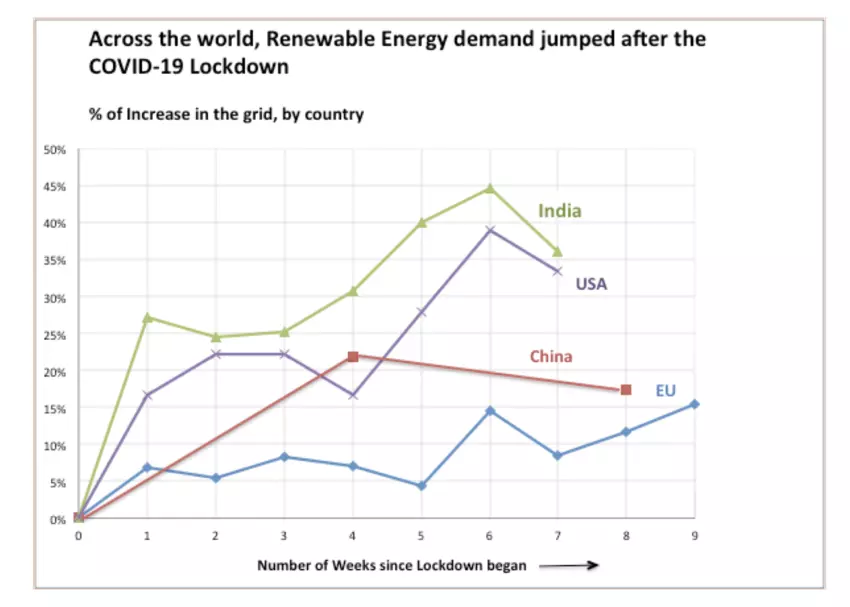A Post-COVID Opportunity for Global Renewable Energy
COVID-19 has unlocked a massive opportunity for the renewable energy sector around the world. Overall, energy demand has decreased and is expected to remain lower as commercial buildings, factories and other large energy users have slowed operations. Residential demand, on the other hand, has picked up as more and more people continue to work from home.
In early 2020, as most governments around the world introduced lockdown measures, electricity demands plunged by as much as 15%-30% in many countries, creating an oversupply of available power capacity. This led to grid operators seeking the cheapest and cleanest supply source to offset the lower demand, resulting in an increased share of renewable energy in the energy mix. Oil prices plummeted.
In the U.S., the Biden administration has signaled its intention to continue moving away from fossil fuels. In all major regions of the world, the power mix has shown a significant shift towards renewables. There’s reason to believe this shift will outlast the pandemic once vaccines have been distributed.
“Renewable energy, now predominant in new electric power capacity, has proven especially flexible, cost-effective, and resilient in the face of the 2020 health and economic crisis,” said Francesco La Camera, the Director General of International Renewable Energy Agency (IRENA).
In late 2020, the US was ranked first among 40 countries in renewable investments worldwide, according to the consultancy Ernst & Young, recapturing the top spot from China for the first time since 2016.
Furthermore, the U.S. plans to invest $57 billion to install up to 30 gigawatts of offshore wind by 2030, the report said. China's growth in renewables has slowed, as the government looks to wean its market off subsidies. Overall, global use of renewable energy in all sectors increased by 1.5% while renewable electricity generation increased by almost 3% in the first quarter of 2020 as compared to the first quarter of 2019 as per International Energy Agency.
COVID-19 offers an opportunity for world governments. As countries enact economic recovery packages they may now find it more appealing to include major reforms encouraging private investors to the renewable energy sector.
This will not only encourage economic recovery, but also contribute significantly towards better environmental conditions. IRENA’s Global Renewables Outlook report finds that each million dollars invested in renewables or energy flexibility would create at least 25 jobs, while each million invested in efficiency would create about 10 jobs.
Energy transition investment can boost GDP and could add 5.5 million more jobs by 2023 with the potential to reach 42 million globally by 2050 which will be four times their current level. Jobs in the renewable energy sector also exhibited a better gender balance, as almost 32% of jobs are held by women as compared to 21% in non-renewable sectors. Governments need to continue to take advantage of the market conditions during and post-COVID-19, ‘green appeal’ of the renewables and their ever-falling price owing to the technological innovations.
However, the renewable energy sector must grapple with many challenges like delays in the construction of new projects due to lockdowns and restrictive movements and disruption of supply chain for projects under construction. Delays in financial closure, payment defaults by renewable energy off-takers, and working capital shortages for small sized projects may further hinder progress.
Notwithstanding the challenges, ample opportunities can be created for supporting the renewable energy sector. Measures taken by policymakers, regulators, and market participants can determine the well-being of the renewable energy value chain.
Some countries have initiated certain measures to support the renewable energy sector. For example, Poland has extended the deadline for renewable energy producers to commence sales within the auction system.
To benefit from this opportunity, one of the key strategic priorities for governments in their economic recovery plans should be to attract private sector investments. This would increase the share of renewable energy in the overall energy consumption mix in the short and medium terms, create new jobs and reaffirm their commitment towards a greener tomorrow.
The short-term recovery also needs to be linked to medium and long-term strategies by way of socio-economic measures. The aim has to be to ensure a permanent shift towards consumption of clean energy and to ensure environmental sustainability. The renewable energy sector might face challenges at this point in time and market factors can only serve as a secondary force to bring the shift.
Hence, to accelerate the adoption, the role of the governments becomes crucial. They need to provide a conducive environment to all the ecosystem partners across the value chain by means of subsidies and policy framework to bring the cost of renewable energy at an affordable level. By putting clean energy at the heart of COVID-19 economic recovery, they can take a big step towards a naturally healthy world, which is the best insurance policy against global pandemics.
Fabricio Pamplona is the founder of Mind the Graph, a tool used by over 400,000 users in 60 countries. He has a Ph.D. and scientific background in Psychopharmacology and experience as a Guest Researcher at the Max Planck Institute of Psychiatry (Germany) and Researcher in D'Or Institute for Research and Education (IDOR, Brazil). Fabricio holds over 2,500 citations in Google Scholar. He has 10 years of experience in small innovative businesses, with relevant experience in product design and innovation management. Connect with him on LinkedIn.

Founder of Mind the Graph
Disclosure statement:
The Institute for Science & Policy is committed to publishing diverse perspectives in order to advance civil discourse and productive dialogue. Views expressed by contributors do not necessarily reflect those of the Institute, the Denver Museum of Nature & Science, or its affiliates.
